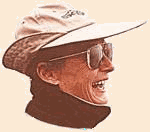|
I certainly have enough food for thought! Between email,
articles, books and conversation with fly-fishing friends my mind is on overload
most of the time. All that does not include the various things necessary to produce
this website each week.
Often I fall asleep with my mind churning about a particular bit of information about
our sport which I am trying to sort out. I should be falling asleep thinking about
fishing some neat place, not the physics of casting.
But it is the physics of casting that keeps gnawing at me. Al Kyte gave me a reprint
of his recent article, 'Fly Casting: Substance and Style' published in the
American Anglers magazine, at the Seattle ISE show. Al and Gary Moran
did real bio-mechanical studies, including filming of several well-known casters, to
determine the essential physics of a cast, those movements which
quoted from the article, "transcend the differences that we observed among skilled casters."
Differences in this cases being height, weight, physical fittness and such.
The most important of those "essential physics" are described as "three sequential
straight-line movements that occur before, during, and after a cast. First the
caster starts a forward casting stroke when the fly line is straightening directly back
from his intended target direction. Next, he accelerated the rod tip and fly line
forward along this target direction. Finally, he stops the rod so that the line rolls
out over itself along this same path in as narrow a loop as possible, until
it straightens again."
"In our study, the 'elite' casters - those who made the longest casts - differentiated
themselves from the less successful 'good' casters by straightening the line more
completely on the backcast (with less line 'sag') accelerating the rod tip along a
straighter path, and stopping the rod more abruptly - causing its tip to unload closer
to the moving fly line, thus forming tighter loops . . ."
Now add to that an email from Bill Van Natter talking about exactly when to start
the forward cast, and is it when the backcast is absolutely flat behind you, or just a
split second before that point since gravity is at work? Take for granted here that
any dip in the line behind you is slack in the line and works against the caster
producing much distance at all. This is all pretty picky stuff, and may discourage
folks who think casting is just too hard. It really isn't - but the way all of us
can improve is to be aware of what makes a cast - and how each of us produces
the cast.
We've taught a lot of folks to cast, and while I'm convinced the basics can be
taught reasonably easily by good instructors, I'm also aware some instructors
insist their students do all the moves exactly the way the instructor does. That is
wrong.
All of us are built differently, physically that is. We develop different muscles
depending on what our work and interests are. And frankly, the guy who has
spent many years with a spinning rod will have a more difficult time learning to
'stop' the rod as required for fly casting than the person who has never fished.
Golfers and tennis players will find casting quite easy.
Guys usually are pretty strong, some more than others - so there is a tendency to
'muscle' the rod, and not to let the rod do the work. One of the ways we handle
that problem, once we have has people doing a basic casting stroke, is to tell
them to make the same cast using half the effort they just used.
Going back to the 'straight line movements' in making the three basic movements.
One of the ways to work on that one is to visualize the rod tip as a felt marker
making a line on the ceiling. If the rod tip dips during the stroke there would be
a skip in the line the felt marker made. That same dip can cause a tailing loop!
Stopping the rod sharply (back to Castwell's article)
by hitting your hand with the rod to see the type and size of the loop which is generated
is an excellent excercise! Casting a long line, or casting into the wind both require
a tight loop, sometimes we call it a wedge. This isn't just something to practice,
it is a very usable tool in your fishing.
Lefty Kreh demonstrates a practice cast which will help tightened up your loops.
Casting a short line, 30 feet or so overhead, see how close you can come to hitting
your rod tip with the line - without actually hitting the tip! (Leave the fly off on this
one if you don't want to damage your rod.)
When we fish, each of us uses the casting stroke and method which is comfortable for us. If you
give some thought to how a cast is made, and practice at home, your actual fishing will be much
more enjoyable.
Don't worry about how you look, or if your casting looks like Lefty's or Castwell's or mine.
Each of us is unique - use what works for you! Just keep working on it. ~ LadyFisher

If you would like to comment on this or any other article please feel free to
post your views on the FAOL Bulletin Board!
|





